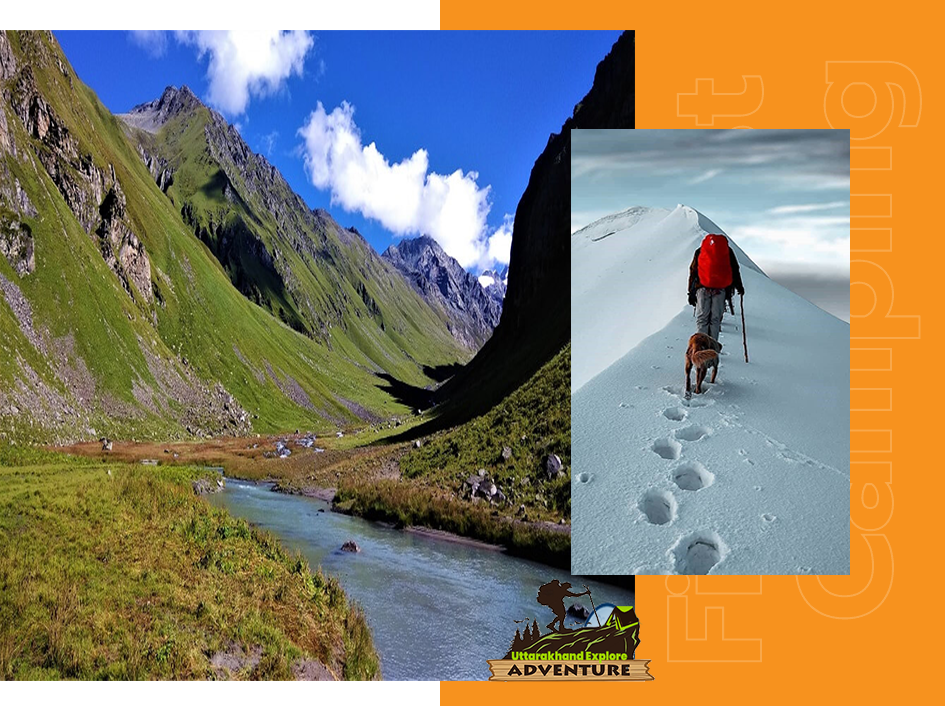01 ABOUT
All About The Bali Pass Trek
- Bali Pass Region: Uttarakhand
- Bali Pass Duration: 8 Days
- Max Altitude: 4,950m/16,200ft
- Trekking Km: 60 Kms
- Bali Pass Grade: Difficult
- Trail Type: A cross over trail through passes.

BALI PASS TREK
We all want to have a journal, to pen down our wordless encounters and fanatical occurrences of life.
Bali Pass is surely that one trek, which can be challenging, but life changing, at one point.
Bali Pass has its own charismatic appearance, and no person ever return untouched of the magic
Historical Significance of BALI PASS TREK–
Emphasize the main attractions of BALI PASS TREK-
Villages of PARVAT/JOUNSARI
Often claimed as the descendants of Pandavas, Jaunsari himachali villages are popular for their cultures and beliefs. The wooden architecture made of Deodar-Pine-spruce trees and white-silvery mountain peaks, unique music, distinct songs and marvelous dance, altogether bring Jaunsari villages into one of the most ambiguous places of Uttarakhand. Every single detail about the place is delightful.
Rivers from mountains-
Yamuna, Tons and Supin rivers cheer us up with concords and harmony.
The rivers deliver the beautiful message from nature to us.
“ In the eyes like oysters, dreams turn into pearls which are meant to be cherished.”
Brahma Kamal /Leser –
A rare, legendary, mythological herb which has medicinal characteristic, campsite near Odari. and spiritually revered, is widely seen in the
Wildlife in Himalayas-
The Govind Wildlife Sanctuary or Govind Pashu Vihar National Park and Sanctuary is established in the supin renge Uttarkashi district of Uttarakhand. . The m–onal pheasant, koklass pheasant, bearded vulture, Himalayan snow cock, golden eagle, western tragopan, steppe eagle and black eagle are some of the endangered feathered inhabitants of this area.
Best time to visit Bali Pass Trek–
- During Winters- Early-September to mid-October.
- During Summers- Mid-May to June-end.
How to reach BALI PASS TREK?
By Rail-
Several trains are available from Delhi to Dehradun. On reaching Dehradun, it takes 10 hours long drive to Sankri (210kms)By Road-
A 9-10 hours drive from Delhi to Dehradun to SankriBy air-
Board a flight from New Delhi to Jolly Grant Airport (Dehradun) and drive to Sankri from Dehradun to Sankri (210kms)By bus-
buses are available from Delhi to Dehradun on regular basis.How safe is the Bali Pass trek-
A person must be physically and mentally healthy to opt for the trek. But it can’t be done unless you try.
Bali Pass Weather/Temperature-
The trek is not advised for the trekkers if they are not trained 2-3 months prior to the beginning of the trek, because BALI PASS TREK is at 16,250 ft and needs proper preparatory exercises to be done.
Day 01: Dehradun to Sankri
The 10 hours drive from Dehradun to Sankri transverses through Mussorie and nearby tourist places.
The trek begins from the base village Sankri located in the Govind Wildlife sanctuary. Evening environment in the base camp enliven in us, a sense of electrification.
Day 2: Sankri to Seema via Taluka
The trek commences in the early morning, and we proceed towards Taluka which is at about 10 kms from the homestay/hotel. From Taluka, we start stepping downwards to the river bed, and slowly reach Supine river.
Villagers are seen, happily and warmly, gleaming with smiles, welcoming all the trekkers. Cemented as well as wooden pathways descend steadily.
Walk for 2 more hours, and the exiquisite wooden architecture Ghanghad village encircle us where we could visit a dhaba, and fill our water bottles.
One more hour through the trail, and we catch a glimpse of the real beauty of Uttarakhand in the village Osla.
Osla is still hidden from the eyes of the government, life is steadier than the steady, and people follow certain old yet gold rules of wearing traditional clothes, and obey the King.
Osla is known for a clan of people who were loyal to Duryodhan during Mahabharat, and they are believed to worship Duryodhan as their ideal till now.
Through the dense forests cautiously, trying to spot Himalayan Monal, we head towards Seema, walking on the sides of Supine river.
Camps are set up at Seema.
Day 3:Seema to Rainbasera
Walking alongside the supine river, ascending, as the paths get steep, as we come near Debshu Bugyal. We locate boulders on the way to Ruinsara village. Osla village starts to be seen in the sight. From Osla, after travelling for an another 30 minutes, we reach a large pastureland in mountains, called Debshu Bugyal, which is spread for about 2kms.
Relax yourself for a while, and just enjoy the beauty of Kala Nag and Black peak.
Luscious meadows become steep as we walk further, towards our campsite Rainbasera.
Spend some time on the boulders and collect lovely memories.
Tents are arranged.
Day 4:Rainbasera to Ruinsara Tal
Would it sound clichéd if I say that today is the most astounding and mind-boggling day of the trek ?
Keep your eyes wide open, and you will be startled at the splendour of crystal-clear water body, and be in awe at the beauty of Mother Nature.
This seems like a picture come out from a movie where life seems like a miracle.
Miracles do happen, and you just have to choose the right trek.
Yamunotri temple is nearby, one must thank the Goddess for the blessings.
Snow clad mountains, dense meadows, eye catching views of Bandarpooch peak, Kala nag, Dhumdhar khai are spectacular.
The trek takes 3-4 hours in total.
Day 5:Ruinsara Tal to Odari
It is not a long, extensive trek on day 5. We just have to walk for 4 kms today, and Supine river plays a vital role in the trek throughout.
Through the steepy pathways, and descending towards the river, we reach Odari. The trek is comparatively easy than the ones we have been doing earlier.
Odari, literally means, cave. And the campsites are near Odari.
The locals tell us a strange story about Bali staying in the cave for one night according to Hindu mythology..
The mid time of the day is specified for training for the next day, as it is an intricate one.
Day 6: Odari to Bali col camp
The reason why Bali pass trek is regarded as one of the most difficult treks of Uttarakhand, is the abrupt climb angled at about 60 degrees.
The trekker has to be stiff, inflexible and firm while walking on the wobbly, unfastened rocks. The tendency of stumbling on stony pebbles must be prevented.
The temperature falls down, and spine-chilling cold flows down the body. Jackets are advised to be worn to avoid catching cold.
Keep yourself hydrated.
Acute mountain sickness is obvious at the height more than 8000 ft.
The day is strenuous and extremely exhausting.
Take rest.
- Personal Insurance
- Medical Certificate
- Personal toiletry Items and Personal Medicine kit
- On first day En Route to base camp the Breakfast and Lunch are Not Included
- Last Day En Route Lunch and Dinner are Not Included</l
